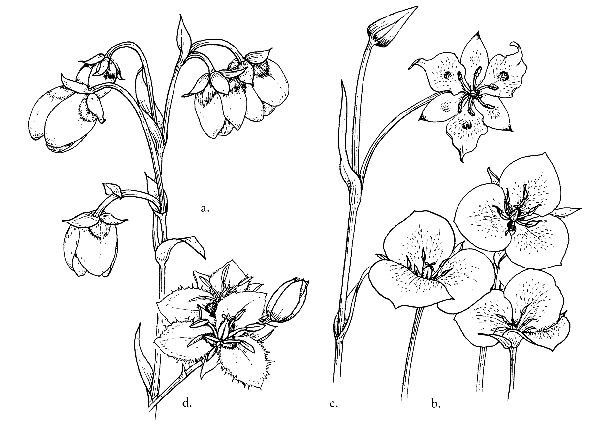A genus of about 60 species of bulbous plants, native to western North American from British Columbia to southern Mexico and Guatemala, with over half this number in California. They may have leafy or leafless stems, with or without branches. In some species bulbils are found in the leaf axils. The stems leaves are generally long, reducing in size up the stem. Additionally, there is a solitary broader basal leaf in sections Eucalochortus and Cyclobothra, but not in Mariposa. The leaves frequently wither by flowering time. Each flowering pedicel is subtended by a leafy bract. The flowers are generally large, white, yellow, pink to red, lavender to purple, and often have blotches or other markings of a contrasting colour. They may be solitary or several to a stem. The outer three perianth segments (sepals) are typically narrower and shorter than the inner three (petals), usually of similar colour but sometimes green. The inner petals are broad, hairy to a greater or lesser extent, with a gland at the base which often has a bearded transverse membrane. The fruits may be orbicular or linear, three-angled to three-winged, erect or nodding, their appearance forming a basis for subdivision of the genus into sections. Some of these subdivisions are of value to the gardener, with obvious differences in flower shape and in their habitat in the wild. The section Eucalochortus has fruits which are orbicular and three-winged. Most have nodding fruits and are further divided into the Pulchelli with globose flowers 2-3cm wide, in U.S.A. popularly named Globe Tulips, the Elegand with erect campanulate flowers 2-3cm wide, with abundant hairs and bearded glands, appropriately named Cats' Ears, and the Nudi with flowers of similar shape and size but without hairs, sometimes called Small Star Tulips. A few species in this section have erect fruits and belong to the subsection Nitidi, and are more closely allied to the Mariposa section. The Mariposae are the largest group and have erect oblong to linear three-angled fruits, and very large, spectacular campanulate or broadly campanulate flowers, of 3-8cm diameter. Members of the Cyclobothra section have similar fruits to the Mariposae but the bulb coat is dbrous-reticulate rather than membranous, and they usually have basal leaves as well as stem leaves. The flowers are campanulate, generally smaller, and may be erect or nodding. Only a few species in this section have been seen regularly in cultivation. The section Eucalochortus comprises generally woodland plants of mountainous areas, whereas the Mariposae grow in open, dry conditions or desert, often among sagebrush. The Cyclobothra section has a more southerly distribution in Southern California and Mexico, and grow in even hotter conditions, but with some summer rainfall.
The genus has a reputation for being difficult to grow, but this is only true of cultivation in the open ground. It is of interest that Gray in his book Hardy Bulbs grew twenty or more species in the open garden, and the writer has had some unexpected successes, notably with Calochortus venustus, so experiments with the Mariposae in a sunny, well drained bed, or with the woodland species in partial shade in a more humus-rich soil, are worth making. Considerable success has been achieved with most species in a bulb frame or in pots in the alpine or cold greenhouse, where they can be given a summer drying-off period. In general a compost similar to John Innes No.2, with extra coarse grit to improve the drainage, is suitable. The woodland species, subsections Pulchelli and Elegand, benedt from the addition of sieved leafmould to the compost. The needs of various species differ considerably in their dormant period, but a good general rule is to withhold water after flowering is over, and to restart in October, or even in November for the later flowering species. Species of the Cyclobothra section flower in late summer and are probably best kept dry until late winter. Calochortus bulbs are rarely available in the trade, but a good range of seed is offered in specialised lists. Sown as soon as the seed is available, germination is usually rapid, within two or three months, even with late sowing. The seedlings should be kept growing for as long as possible, only withholding water when the leaves are obviously dying down. The bulbs are usually too small to pot after one season, and are better grown on in the original seed pot for a further year, giving them an occasional liquid feed of half-strength fertiliser. They are then repotted into the compost used for adult bulbs, and repotted annually until they attain flowering size in three to five years. (All belong to the Mariposa section unless otherwise stated)

a, C. albus; b, C. apiculatus; c, C. barbatus; d, C. lyallii;
Sign up for our newsletter to receive our monthly update direct to your inbox. Featuring our latest articles and news.
Built by Atomic Smash

